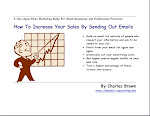Case Studies - 3 Steps to a Powerful Marketing Message
Posted by Charles Brown at Thursday, May 29, 2008What do you find more credible, someone who brags about how their company is "the best," or a third party endorsement by a very satisfied customer of that same company?
It goes without saying, doesn't it, that a third party can give your message far more believability than you could ever give it by "tooting your own horn"?
Third Party Testimonials
Third party endorsements are the ultimate marketing tool, if you can get them.
This is why companies spend so much time and money on public relations. One mention in the media is worth millions in advertising. Not because the exposure reaches more people, but because the impact of being touted by a newspaper, television program or radio show is so much more credible.
Depending on which research study you read, the average American is exposed to over 10,000 advertisements or marketing messages a day. Which begs the question, why in the world should they tune into your message amidst all that clutter?
A third party, who has experienced how good your product or service is, and how helpful your customer service staff is, will be listened to. The hearer knows this is a different message than the typical self-serving promotional material most marketers proclaim.
As a result, this simple message by another party will always cut through more of the clutter than your own message which is always viewed as suspect if it is heard at all.
The Power of a Compelling Story
Now, in addition to the power of a third party singing your praises, what if you communicated your message in the form of a compelling story?
A story with a plot and drama. A story in which one of your customers faced a major problem and your company helped them resolve that problem and achieve a successful outcome?
Stories are powerful. They engage people and draw them in. They allow people to see themselves and their own circumstances in this other person's or other company's struggle to overcome a problem.
So now we have considered the possibility of communicating your message by means of a third party endorsement and a compelling story. What if your message also contained useful and valuable information?
Helpful Information and Expertise
This information could simply be in the form of a few tips on how to solve problems or avoid costly mistakes. It should also contain your company's expertise on solving or preventing such problems for your clients.
In other words, the useful information you convey should demonstrate that your company is very good at what you do without bragging or "tooting your own horn."
So how can you package your message in such a way that it contains a third party endorsement, a compelling story and helpful information?
Case Studies: A Very Powerful Marketing Tool
We are talking here about case studies, also known as client success stories.
I'm sure you have some satisfied customers who are pleased with your product or service. Why not ask them if you can have someone interview them for a case study? As mentioned earlier, the case study will have a plot which consists of the client's problem and how you helped them solve it.
But it should also contain quotes from your customer's key managers who say good things about you. And it should conclude with valuable, practical information from you.
The finished case study should read like a short magazine article, and can then be included in an ad, sent to the media as a press release, or posted on your website. (Read a previous article on this site, Ten Ways to Boost Your Sales With Case Studies, for more ways to promote your business with case studies).
Regardless of the form, you can bet that your case study will cut through a lot of the clutter that bombards your prospective customers each day. The same people who ignore your costly ad campaign will pay attention to a well-written success story.
You will probably find that most of your business clients will be very willing to be featured in a case study. All you really have to do is ask.
COPYRIGHT © 2008, Charles Brown

Labels: case studies, info products, storytelling
Subscribe to:
Post Comments (Atom)



0 comments:
Post a Comment